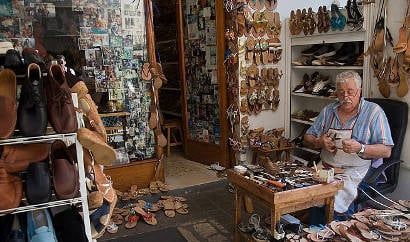Bukola Asafa, a 30-year-old mother-of-two from Nigeria, stitches a deep red lining for a pair of made-to-measure grey moccasins, while around her others mould wooden models for high heels or shape leather on thunderous fleshing machines.
"I studied for an MBA at Liverpool University then opened my own company making bags in Lagos. Now I'm here to get that 'Made in Italy' touch for shoes. The designs will be mine, but influenced by Gucci!" she said with a wide grin.
She is not alone in travelling to Florence to learn from master cobbler Angelo Imperatrice, 75, who was taught the trade aged 11 by his uncles. Some of his students go on to sell their shoes for €3,000 ($3,991) a pair.
Imperatrice is from the Basilicata region in southern Italy but grew up in the Tuscan city famed for leather-working, where the cobbled streets "once thrived with artisans, from silversmiths to watchmakers and knife-sharpeners", he said.
The bustling streets near Michelangelo's statue of David may sport trendy shops with dazzling shoe displays, but it is the Oltrarno area on the other side of the river where the heart of Florence's ancient artisan sector thrived.
"Crafts like these have fallen out of fashion, but young people would do well to consider cobbler apprenticeships. They could become the next Salvatore Ferragamo," he said, referring to the Florentine designer loved by A-listers.
The blue-eyed master teaches up to eight students at a time at the Accademia Riaci – there is a long waiting list – and around 100 have graduated so far.
Amid the rolls of suede, calfskin leather and cord stand finished models, from a pair of towering patent-red heels with a seductive, winding ankle-strap to a lower-heeled blue velvet-lined court shoe with a small gold fork as a clasp.
Mashizan Masjum, a television producer from Singapore, said he had long dreamt of designing women's shoes – "elegant, but with an edge" – and believes he and his fellow students from Japan to South America will help keep Italian shoemaking alive.
"In this class we have people from all over the world learning from the same Italian master: it's globalisation at its best. There is a crisis, but with every crisis comes opportunity," the 41-year-old said as he nailed down a sole.
Returning to the old trades
Imperatrice says that while cobbler apprentices used to work unpaid for four years on repairs before they were allowed to begin shoemaking, freshly trained shoemakers can now set up shop fairly quickly for between 4,000 and €5,000.
Elderly masters of his generation often cannot read or write and are unwilling to face the bureaucratic hassle which modern apprenticeships bring, he says, but they still have a huge amount to teach about the ancient craft.
Several students say their interest in a hands-on trade has raised eyebrows. Dana Alseif, 25, from Saudi Arabia, worked for a while in private banking before risking the wrath of her engineering family to do an intensive Italian language course and indulge her passion for classic men's shoes at Riaci.
The only Italian on the eight-week course – which costs €5,100 – is Daniele Ortolani, a 31-year-old who had been repairing shoes for eight years when he decided to learn how to make custom-made models for people with orthopaedic conditions.
"Some of my friends were surprised when I chose to become a cobbler, but others are now considering the old trades. Being an upholsterer or rag-and-bone man is an increasingly appealing way to beat the economic crisis," he said.
Imperatrice has high hopes for Ortolani, who he hopes will become the next Stefano Bemer, a renowned Tuscan cobbler who boasted Oscar-winning actor Daniel Day-Lewis among his pupils, before dying in 2012 aged just 48.
Bemer took the British actor in as an apprentice for eight months between 1999 and 2000, welcoming him in to his tiny workshop at 8:00 am every day to learn how to make shoes using 180 different leathers, including hippopotamus and sharkskin.
"I want to join the greats some day," Ortolani said.
"I fear there will always be fewer Italian cobblers, but I hope the Tuscan expertise will somehow survive."



 Please whitelist us to continue reading.
Please whitelist us to continue reading.
Member comments